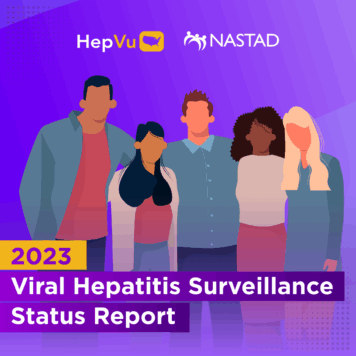Chari Cohen is Director of Public Health for the Hepatitis B Foundation. She conducts programs and research focusing on reducing health disparities related to Hepatitis B infection and liver cancer. Dr. Cohen is director of Hep B United Philadelphia, and Chair of the Coalition Against Hepatitis for People of African Origin. She also helps lead the Hep B United national coalition.
Fifty years after the discovery of the Hepatitis B virus, researchers have made great strides towards addressing this serious liver disease. There is now a safe vaccine that has saved millions of lives, which provides us with an effective strategy for preventing mother-to-child transmission, and helps us to dramatically reduce new cases of acute Hepatitis B infection. Yet, there is more work to be done. There are still an estimated 20,000 new HBV infections in the U.S. each year, and up to 800-1,000 babies who are infected at birth1,2.
There are major Hepatitis B and liver cancer-related health disparities facing Asian Americans, Pacific Islanders, and those of African descent. And overall, only 25% of chronically infected individuals are diagnosed, and only 5% receive FDA-approved treatment3. We are at an exciting time in the world of Hepatitis B, where researchers speak of a cure within a decade, and the World Health Organization has set a goal for elimination of this deadly disease by 2030. We appear close to the finish line, yet we still have miles to run in the race against Hepatitis B.
Hepatitis B is one of the most common and serious liver infections in the world, caused by the Hepatitis B virus (HBV), which leads to lifelong, chronic disease in up to 240 million individuals worldwide and 2.2 million Americans4,5. A leading cause of cirrhosis, liver failure, and liver cancer, HBV continues to have a devastating impact on many communities in the U.S., particularly Asian Americans, Pacific Islanders, and those of African descent, who make up 75% of the HBV burden. In these communities, between 4% and 20% of individuals are infected, and 1 in 4 will die prematurely from HBV. Without the first steps of diagnosis and linkage to appropriate care, infected individuals can’t successfully access the care and treatment needed to prevent disease progression — or a cure when one becomes available. This leads us to the question: are we ready for a Hepatitis B cure?
When a cure is developed, we will need to ensure that infected individuals are made aware of their diagnosis, and linked with appropriate medical care. This means overcoming multiple barriers to HBV testing and care. First, HBV is generally a silent disease, so someone can feel healthy while infected for decades, negating the perception of the need for testing. Additionally, there is a lack of knowledge about HBV among health care providers, communities at risk, and the public. This hinders HBV testing rates, and creates a culture of fear as misinformation and myths replace knowledge, further preventing people from being tested.
Unfortunately, those most likely to be infected with HBV are also those with the most barriers to health care access, including limited English proficiency, lack of health insurance, and difficulty navigating the complicated U.S. health care system. These are compounded by financial, work, transportation, and time-related barriers. Finally, HBV is a highly-stigmatized disease, due to the lack of knowledge compounded by cultural beliefs and widespread discrimination in many countries. People fear the loss of a job, being kicked out of school, becoming un-marriageable, and being isolated from family members. Many would rather not know that they are infected, so they don’t have to face the potentially ruinous consequences.
The barriers to HBV testing and care, as described here, barely scratch the surface of the complexity of the situation, and the challenge of overcoming them, which can seem insurmountable. Researchers, however, are optimistic there will be a “functional cure” for HBV within the next decade, which although is short of a complete cure, would still put elimination of HBV within our grasp. Yet, how can we ensure the 2.2 million chronically infected Americans will have access to a future cure, when we are still struggling to get them tested?
For the past decade, community leaders, researchers and public health professionals have worked to develop evidence-based strategies to reduce barriers and improve HBV testing and linkage to care among high-risk communities in the U.S. These community-based strategies have increased HBV screening by up to 40,000 people each year. However, relying on these programs to solve the problem of low testing and health care access rates puts an immense burden on the community, and does little to foster systems-level change. More work needs to be done to integrate risk-based HBV testing at the provider level, to mitigate some of the burden on community programs.
Getting ready for a Hepatitis B cure begins with testing, diagnosis, and linkage to care. As we get closer to a cure, now is a critical time to increase the investment in public health infrastructure—so that evidence-based community testing strategies can be sustained, replicated, and scaled-up—and to develop and implement strategies for improving HBV testing in primary care settings. Websites like HepVu.org that increase awareness of the viral hepatitis epidemic are critical to our success in winning the race against Hepatitis B. We must create an urgency to prioritize Hepatitis B research and infrastructure so we can bring everyone across the finish line.
Notes
- National Academies of Sciences, Engineering, and Medicine. 2016. Eliminating the public health problem of hepatitis B and C in the United States: Phase one report. Washington, DC: The National Academies Press.
- 2012a. Epidemiology and prevention of vaccine-preventable diseases. 12th ed, 2nd printing ed. Washington, DC: Public Health Foundation. Pp. 115-138.
- Cohen, C., Holmberg, S., McMahon, B. J., Block, J. M., Brosgart, C. L., Gish, R. G., . . . Block, T. M. (2011). Is chronic hepatitis B being undertreated in the United States? Journal of Viral Hepatitis, 18, 377‐383.
- Schweitzer A, Horn J, Mikolajczyk RT, Krause G, Ott JJ. (2015). Estimations of worldwide prevalence of chronic hepatitis B virus infection: a systematic review of data published between 1965 and 2013. Lancet. 17;386(10003):1546-55.
- Kowdley, K. V., Wang, C. C., Welch, S., Roberts, H., & Brosgart, C. L. (2012). Prevalence of chronic hepatitis B among foreign‐born persons living in the United States by country of origin. Hepatology, 56(2), 422‐433. doi: 10.1002/hep.24804






